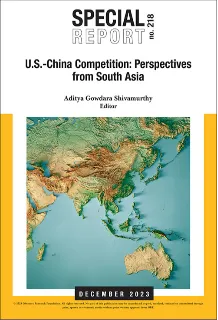Introduction
On 8 November 2023, the United States’s (US) International Development Finance Corporation (DFC) announced a loan of US$553 million for Sri Lanka to develop the Colombo port’s west container terminal, thereby making the island nation the DFC’s second-largest market in the Indo-Pacific.[1] This was only one of the recent indications of the increasing importance being accorded by the US to a South Asian country. In the last three years alone, the US has sought to heighten its defence and security cooperation with the Maldives and Bangladesh and commenced its Millennium Challenge Corporation (MCC) projects worth a grant of US$500 million with Nepal.[2] As the Indo-Pacific grows in prominence in global geopolitics, the US is countering China’s influence by offering alternative development partnerships and attempting to maintain a favourable balance of power in the region.
Despite India’s strategic clout in South Asia, the region has not been immune to broader structural shifts caused by the bilateral dynamics between the US and China. The US’s approval of China’s membership to the World Trade Organization (WTO) and its accommodation of China as a “responsible stakeholder” from the early 2000s accelerated the latter’s economic growth and integration.[3] This enabled China to develop trade and development partnerships in South Asia with little scrutiny. The 2008 global financial crisis further entrenched China’s influence in these countries. China’s diversified relations, historically focused on Pakistan, have expanded in other countries in the form of loan provisions, investments, political engagement, people-to-people contacts, and military and defence cooperation. These initiatives were further institutionalised under China’s Belt Road Initiative (BRI), launched in 2013. Beginning that year, China made bigger investments in South Asia and by 2022, that figure had breached US$100 billion.[4]
Since then, and especially from 2017, tensions between the US and China have escalated.[5] China’s aggressions in the South China Sea and Taiwan, its treatment of the Uyghur minorities, unfair trade practices, and trade and technology wars with the US which prompt the latter to accuse it of intellectual property theft—have caused the competition between the two countries to heighten in recent years. The US is increasingly seeing China as a threat to its hegemony and the preservation of the Western values-based order, and is responding through its Indo-Pacific strategy.[6] The strategy advocates for robust engagement with the Indo-Pacific countries, both bilaterally and in collaboration with regional partners.
South Asia—a crucial geography at the heart of the Indo-Pacific region—is not exempt from the consequences of the ongoing US-China tussle. Indeed, there is growing interest in the South Asian region, and it is being driven by multiple factors. Primarily, South Asia will be useful for both the US and China for accessing and maintaining their presence in the Indian Ocean and securing their sea lines of communication and trade. The region also aligns with their respective strategic ambitions: it helps China counter India’s influence and presence in the region and enhances its status as an Asian power;[7] for the US, the region offers an opportunity to push back against China through India. Finally, China’s lending, investments, and projects in the region will help China expand its economy and trade, while offering it the leverage to mitigate any potential unrest in Xinjiang and Tibet.
To be sure, South Asia remains vulnerable to China’s unsustainable and opaque lending policies, white-elephant projects, and unfair trade practices. As a response, the US is involving itself in the region—both bilaterally and in collaboration with its regional partner, India—in strengthening democracy and democratic institutions, promoting market access, development, maritime security and defence, and covering infrastructure gaps.[8] The prospects of such cooperation have further increased following India and China’s clashes at Galwan in 2020.
At a time when the tensions between the US and China are escalating without any prospect of end in sight, this special report attempts to provide South Asian regional perspectives on the US-China rivalry. The six essays in this report attempt to capture insights and perspectives from analysts in South Asian countries often missed when studying the broader structural changes in the Indo-Pacific and the evolving US-China competition. As this report highlights, South Asian countries are not passive victims of the geopolitical churning. Despite advocating for non-alignment, these countries are actively leveraging and exploiting the rivalry to further their own national interests, recognising that both countries bring unique benefits to their development goals.
China continues to appeal to South Asian countries for its easy flow of capital, less bureaucratic red-tape in lending, development assistance, investments with fewer conditions, and ability to promote connectivity and mega-infrastructure projects. At the same time, these countries also acknowledge that China’s capital, influence, and institutional and multilateral strength are no match to that of the US. The United States, for its part, helps these countries in domains such as food security, climate mitigation, health, education, disaster management, energy, democratic institution-building, counterterrorism, and security and defence.
In the first chapter, Ayesha Siddiqa gives three reasons why, despite China’s economic, military, and strategic relations with Pakistan, the latter refuses to unequivocally take its side: domestic vulnerabilities; the potential benefits from both powers; and its history of adopting a neutral stance with both. In Afghanistan, Javid Ahmed argues in his piece, the Taliban remains non-aligned even after 20 years of the US-led war on terror. He explains that the US is the Taliban’s preferred partner due to its financial and diplomatic clout, while China is a necessary economic partner.
Bhagya Senaratne follows with an exposition of how a strategic culture of non-alignment, domestic compulsions, and wedging, are shaping Sri Lanka’s foreign policy. In the fourth essay, Amish Raj Mulmi uses the examples of the Millennium Challenge Corporation (MCC) Compact and the State Partnership Program (SPP) to highlight how China uses the Communist Parties and the civil society in Nepal to limit the US from furthering its interests in the country. These developments have compelled the US to counterbalance China by committing to invest an additional 1 billion dollars in Nepal, assisting the nation in strengthening its democratic institutions, and enhancing cooperation and collaboration with India.
The pattern of balancing is not very different for the Maldives, as described by Rasheeda Didi in her chapter. Its strategy of non-involvement and non-partisanship allows the country to gain from the rivalry given its need for development assistance, and especially because the US and China have different priorities in the Maldives, to begin with. Nur Ahmed rounds up the report with an article that focuses on how Bangladesh—a rising power in its own right—cannot yet afford to choose a side. The article delves into the different nature of partnerships and the importance of the US and China for Bangladesh, even as it maintains its principle of ‘friendship to all, malice towards none’.
By looking at the US-China competition through the eyes of six different South Asian scholars, the report highlights how these states are responding to the rivalry. The aim is to build deeper understanding on the interrelated and complex issues, which will be crucial for the readers to familiarise themselves with the region as its importance in global geopolitics grows in the coming years.
Read the report here.
Aditya Gowdara Shivamurthy is an Associate Fellow with ORF’s Strategic Studies Programme.
Endnotes
[1] Benjamin Parkin and Chloe Cornish, ”US lends $553 mn to majority Adani-owned port in Sri Lanka,“ Financial Times, November 08, 2023.
[2] “Formal Implementation of multi-million US Dollar MCC pact begins in Nepal,” Times of India, August 30, 2023.
[3] Council on Foreign Relations, “U.S. - China relations (1949-2023),” Council on Foreign Relations.
[4] Foreign Affairs Committee, “China Regional Snapshot: South Asia,” Foreign Affairs Committee, November 14, 2022.
[5] Council on Foreign Relations, “U.S. - China relations (1949-2023).”
[6] Aditya Gowdara Shivamurthy, “Locating Sri Lanka in Biden’s Indo-Pacific Strategy,” Observer Research Foundation, ORF Issue Brief No. 654, August 2023.
[7] C. Raja Mohan, “China’s Two Ocean Strategy puts India in a Pincer,” Foreign Policy, January 04, 2022.
[8] Aditya Gowdara Shivamurthy, “Locating Sri Lanka in Biden’s Indo-Pacific Strategy.”
The views expressed above belong to the author(s). ORF research and analyses now available on Telegram! Click here to access our curated content — blogs, longforms and interviews.

 PDF Download
PDF Download



 PREV
PREV


